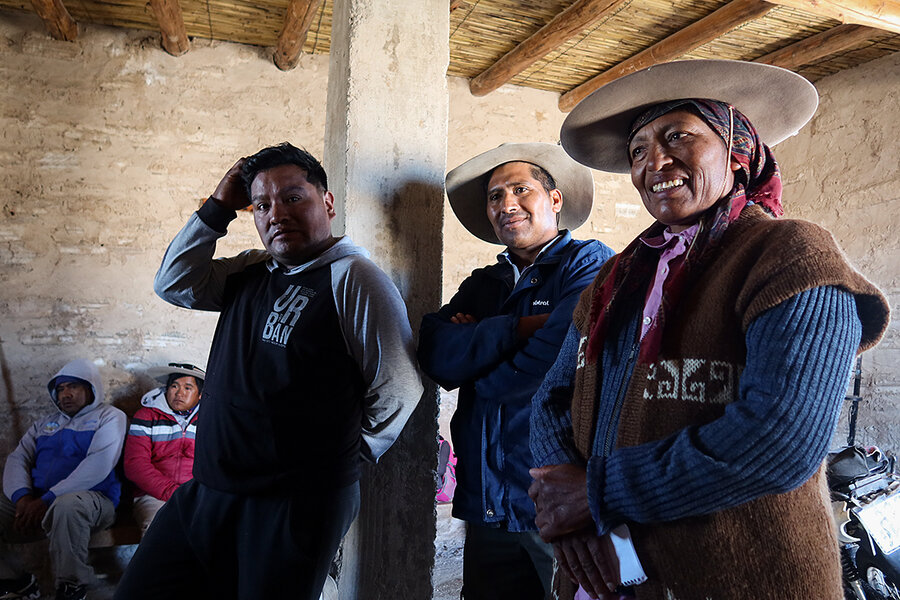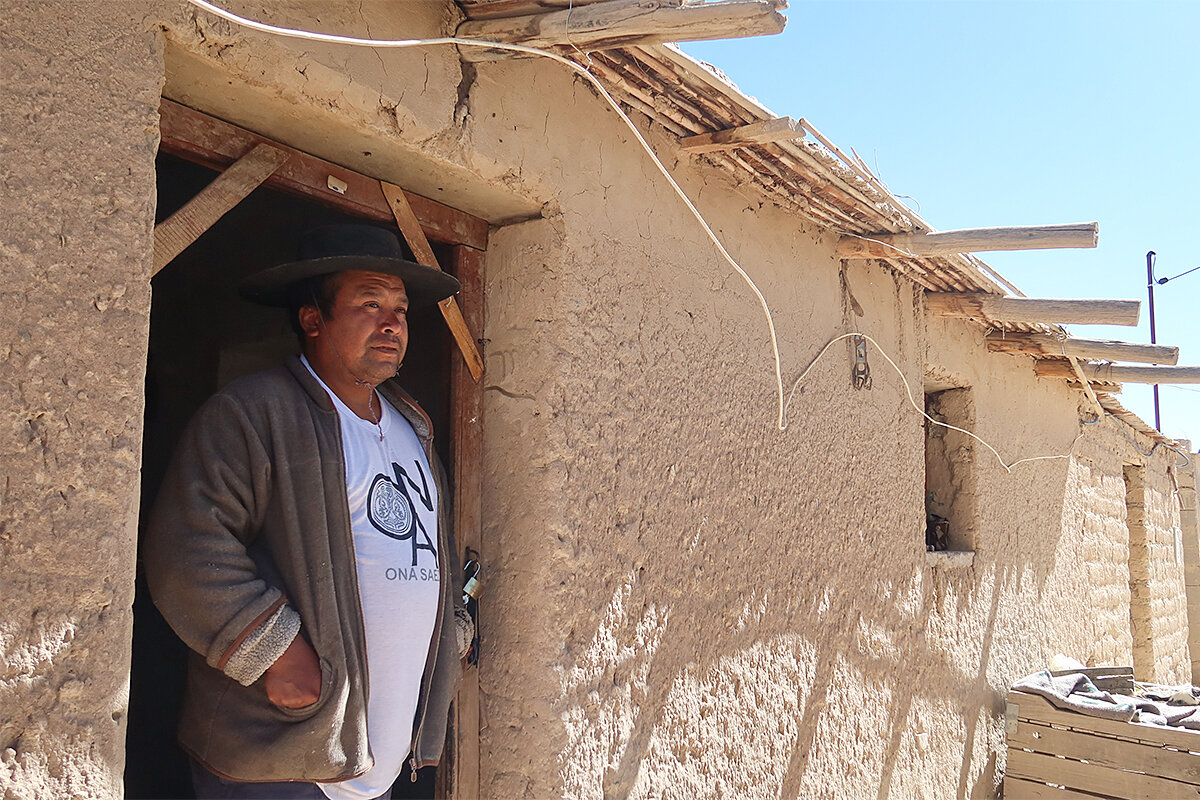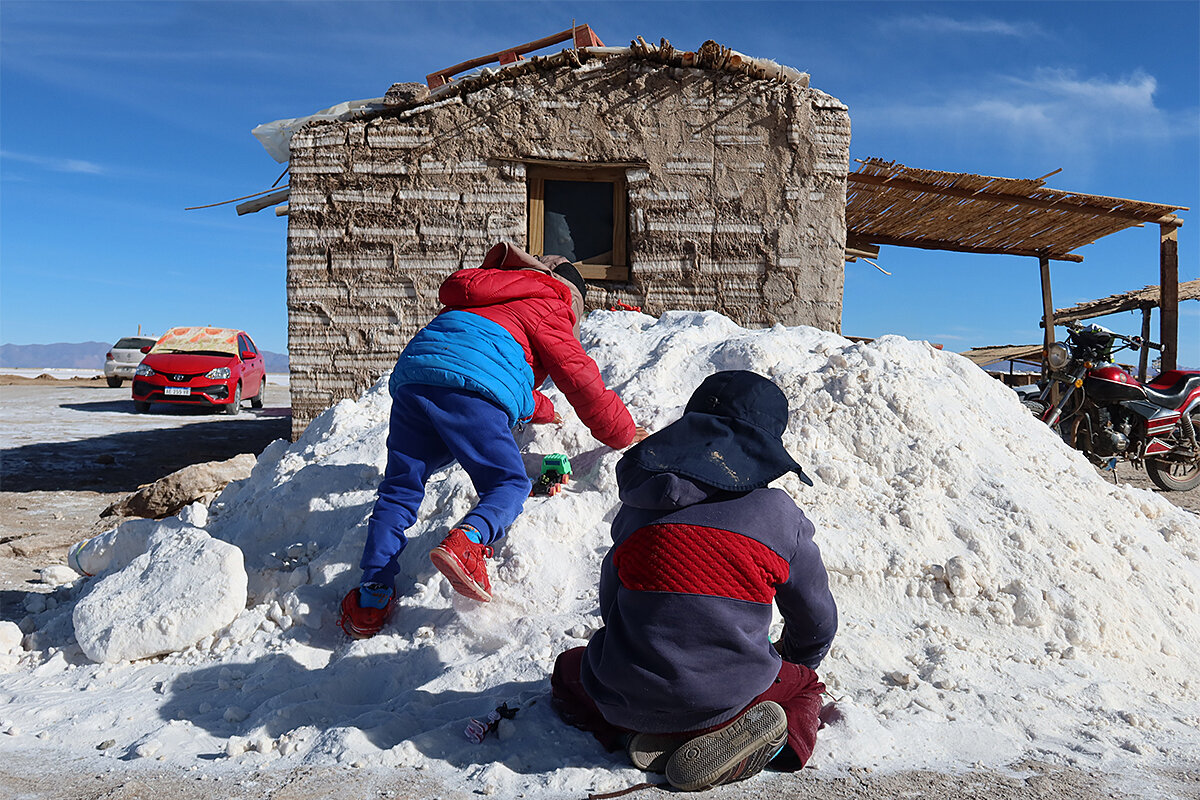Lithium mining boom in Argentina sparks hope – and sacrifice
Loading...
| San Miguel de Colorado, Argentina
In San Miguel de Colorado, a hamlet 12,000 feet up in the arid mountains of northern Argentina, live some of the poorest people in the country, in one of its driest corners.
Beneath their feet lies wealth – one of the world’s richest reserves of lithium, a mineral critical to greening the world economy – that international mining companies are rushing to exploit. But local residents, predominantly Indigenous people, fear for the future of their scant water, which is key to the industrial extraction process.
Lithium “is a resource ... for the whole world,” says Abdón Valdiviezo, a community leader in San Miguel, standing outside his adobe home in the province of Jujuy. “But there is no commitment to our future. If we lose our water, we’ll have to leave.”
Why We Wrote This
A story focused onLithium is in high demand as the world moves toward green energy to meet climate targets. But the benefits of lithium are still up for debate in local mining communities.
For the planet, lithium represents hope. For the farmers and herders of this stark region, it risks meaning sacrifice; they are calling on the authorities to strike a balance between the immediate global demand for the mineral, and their long-term livelihoods.
They are racing against the clock to ensure that their voices are heard, that water reserves are protected, and that local people share in the underground wealth.
“Lithium is being branded as the resource to help halt the climate crisis,” says Erika Weinthal, an environmental policy expert at Duke University in Durham, North Carolina. But local communities, “many of whom are Indigenous,” she points out, “rarely benefit from the revenue.”
Growing demand
As urgency to address the climate crisis grows, the lithium industry is expanding rapidly, especially in Argentina, where regulation is lax and royalties are low. Before 2015, there were two lithium mining projects operating here. Three dozen projects have been approved since then and are in varying phases of exploration and construction.
Román Guitián says his parents, grandparents, and relatives as far back as he knows all drank from the Los Patos river, which runs by his village in Salar del Hombre Muerto in the province of Catamarca, which neighbors Jujuy. This is the site of Argentina’s oldest lithium mine, opened in 1997, a supplier for companies like Tesla and BMW.
Since lithium production began, community members have bought bottled water out of precaution, allowing only their llamas, sheep, and goats to drink from the river for fear of contamination from the operations. Mr. Guitián worries they could lose the river entirely. A segment of the Trapiche river disappeared years ago after the same company set up a dam to collect fresh water for use in the mine, he says.
“It dried up and no one said anything,” says Mr. Guitián, the cacique, or leader, of his Indigenous community. He says six other companies are exploring in the region.
Producing one ton of lithium generally takes 2 million liters of water (just over 528,000 gallons). Brine is pumped up from underground into massive ponds to evaporate so that the remaining lithium salts can be processed. Some companies use a method called direct lithium extraction to recycle a portion of the wastewater, but it’s not a widespread approach.
Demand for lithium is expected to multiply over 40-fold in the next two decades as countries deliver on their climate targets. U.S. regulators have proposed new rules that would make two-thirds of car models electric by 2032.
The “lithium triangle” of Argentina, Chile, and Bolivia holds close to 60% of the world’s known reserves. Bolivia has long taken a state-centric approach to its lithium industry, while Chile announced a plan to nationalize the sector last month. Argentina, desperate for foreign investment to ease its economic woes, has adopted the most market-friendly model, with government royalties on exports at 3%. Royalties can reach 40% in Chile.
“Where are the studies? How do the aquifers behave? Who is going to take responsibility?” asks Mr. Guitián. “They’ve never explained that to me.”
He and other activists have organized protests for stronger protections but say local media rarely cover their concerns anymore as the region has moved forward in favor of lithium mining. But demonstrations have had an effect elsewhere in the world, leading to a pause in a lithium project in Chile and the shutdown of another in Serbia last year.
“A lot of unknowns”
On paper, Argentina’s environmental protections are “the best in Latin America,” says Gustavo Gómez, a federal prosecutor for three northern provinces. “The problem we have is that we don’t apply them,” he says. That leaves companies to largely regulate themselves.
Some say the nature of the green energy sector means those involved with lithium are more conscious of their local impact than in other industries.
“The companies and the ways they develop the lithium projects have very strict regulation and efficiency parameters when it comes to environmental care, and especially water use,” says Ignacio Celorrio, president for Latin America of Lithium Americas Corp.
Federal legislation gives Indigenous communities the right to be consulted about the extractive projects that affect their territory. Lithium companies have reached agreements with some local Indigenous communities. Others say they received environmental impact reports but were not consulted about the information presented, or they received nothing.
“If you don’t have the consent of the communities related to the project, it’s very difficult to move forward,” says Mr. Celorrio. But, he adds, “there are many communities not directly connected to the projects,” making it difficult to speak with everyone.
Locals say the nature of water sources can mean that all communities in the vast arid region known as the Puna are affected regardless of their immediate proximity to operations. In the scramble for foreign investment, provincial governments regulating the lithium industry may not be considering the potential impact of so many new mines using the same water sources at once, say environmentalists.
“They’re pressured and in a hurry to approve the projects,” says Felicity Arengo, associate director of the Center for Biodiversity and Conservation at the American Museum of Natural History in New York. She says there are limits for freshwater extraction but no restrictions on brine or lithium itself. “The science lags behind how fast it’s going.”
Unusually large profits in lithium production are attracting new companies all the time, although prices have fallen this year after surging in 2022.
“In this boom, there literally is enough to go around,” says Kathryn Ledebur, director of the Andean Information Network in Bolivia. “There’s enough to benefit the Indigenous peoples, to take care of the environment, and to provide a safety net for the producing countries while providing lithium batteries and clean energy for consuming countries.”
More than a “resource”?
The lithium-rich Argentine provinces of Jujuy, Salta, and Catamarca have long struggled with scant private sector jobs. For some, the arrival of new mining companies comes with trade-offs worth accepting.
“We all know that long-term, the mines are harmful to the people and for the water supply,” says Rodrigo Ayala, a taxi driver in San Salvador de Jujuy whose income has multiplied since the company he works for began catering to a lithium company. “But we need the money,” he says.
Most days of the week, members of the San Miguel de Colorado Indigenous community can be found at the Salinas Grandes salt flats, a popular tourist attraction and one of the sites in advanced exploration for lithium extraction. They gather in a hut for guides, taking refuge from the harsh sun and wind as they wait for tourists to arrive. A sign staked in the expanse of salt outside reads, “No to lithium. Yes to water and life on our territory.”
“The state sees our land as a resource. We see it as part of our being,” says Macadonio Carrillo.
Carlos Chuchuy, a leader from another Indigenous community 70 miles north, is visiting the flats in solidarity. His father worked his whole life in lead mines, and his son is studying mining engineering. Mr. Chuchuy is holding out hope that his son’s degree will lead him to a safer way to approach the region’s lithium.
The way things stand, he says, “lithium is bread for today, hunger for tomorrow.”
Editor's note: This story has been updated with the correct spelling of the name of the director of the Andean Information Network in Bolivia.










